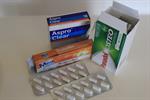
Improve your use of medical English to improve your job and careers prospects in the health services.
Communicate better with both Doctors and patients?
A special course designed for people working or wishing to work in medical environments, with no medical training, to develop skills to communicate clearly and effectively using medical terminology.
This course is relevant to anyone working or wishing to work in fields of health, alternative medicine or paramedical areas; such as reception for a doctor or natural therapist.
Lesson Structure
There are 10 lessons in this course:
-
Scope and Nature of Medical Terminology
-
What is Medical Terminology
-
Origins of Words
-
Structure of Words
-
Medical Prefixes
-
Medical Suffixes
-
Constructing Medical Terms by altering prefix or suffix
-
Anatomical Structure
-
Anatomical Prefixes
-
Anatomical Suffixes
-
Locating parts of the body
-
Terms to indicate positioning of anatomical features in body
-
Acronyms
-
Symbols
-
Medical Equipment and Procedures
-
Terms to describe Diagnostic and Surgical Procedures
-
Terms to describe Medical Equipment
-
Storage and Handling of Medicines
-
Sterilising Equipment
-
Terms to describe Bacteria
-
Gram Staining
-
Diagnostic Microbiology
-
Research Microbiology
-
Types of Wounds
-
Problems Resulting from Wounds
-
Treating Wounds
-
Electrolytes
-
Examples of Prefixes and Suffixes
-
Pharmacological Terminology
-
Types of herbal and pharmaceutical medicines (eg. Alkaloids, Calmatives, Cathartics, Decongestants, Expectorants, etc)
-
Pharmacological Terms (eg. Allergens, Carcinogens, Photosensitisers, Toxic Alkaloids, etc)
-
Over the Counter Prescription Drugs
-
Terminology for OTC and Prescription Drugs (eg. Steroids, Barbiturates, anti-Psychotic Drugs etc)
-
Prefix and suffix examples
-
Musculoskeletal System Terminology
-
Naming main muscles
-
Musculature ... Types of Muscle tissue
-
Relationship between muscles and bone
-
Bone and Joint problems (eg. Sprains, Broken Bones, etc)
-
Disorders of musculoskeletal System (eg. Fibromyalgia, Sprains, strains, Cramp, etc)
-
Suffix Examples
-
Cardiovascular, Lymphatic and Immune Systems Terminology
-
Parts of the Heart
-
Circulation
-
Systole and Disystole
-
Terms related to Disorders of Cardiovascular System
-
Lymphatic System and Immunity
-
Leucocytes
-
Vaccination
-
Immunity
-
Disorders of Immunity
-
Suffix and Prefix Examples
-
Respiratory and Reproductive Systems Terminology
-
Lungs
-
Respiration
-
Pulmonary Circulation
-
Gas Exchange (Diffusion, Perfusion, Arterial Pressure)
-
Carbon Monoxide Poisoning
-
Diagnostic Procedures for Lungs and Airways
-
Respiratory Disorders
-
Male Reproductive System (Penis, Testes, Scrotum etc)
-
Female Reproductive System
-
Pregnancy
-
Parturition
-
Caesarian Section, VBAC and Multiple Gestation
-
Premature Birth and Miscarriage
-
Reproductive Disorders (eg. Amenorrhoea, Menorrhagia, PCOS, Endometriosis, etc)
-
Suffix and Prefix Examples
-
Digestive and Excretory Systems Terminology
-
Parts of the Digestive System
-
Renal System
-
Kidneys
-
Ureters and Bladder
-
Urethra
-
Disorders of Digestive and Renal Systems (eg. Anal Fissure, Haemorrhoids, Inflammatory Bowel System, Kidney Stones, Pancreatitis, etc)
-
Suffix and Prefix Examples
-
Integumentary System (Skin) Terminology
-
Thermoregulation
-
Electrolytes
-
Types of Sensory Nerves
-
Sun Protection
-
Integument Structure
-
Cell Types
-
Disorders (eg. Scab, Atrophic skin, Abrasion, Excoriation, Scar, Ulcer, etc)
-
Diagnostic Procedures
-
Suffix and Prefix Examples
-
Nervous and Sensory Systems Terminology
-
Brain
-
Central Nervous System
-
Peripheral Nervous System
-
Disorders of Nervous System
-
Disorders of Sensory System (eg. Aphasia, Apraxia, Vertigo, etc)
-
Diagnostic Procedures
-
Suffix and Prefix Examples
Aims
-
Explain the scope and nature of terminology used in medicine and allied professions.
-
Identify the meaning of words that describe general anatomical features, including disorders.
-
Identify the meaning of words which describe medical tools, equipment and procedures.
-
Identify the meaning of words that describe pharmacological terms.
-
Identify the meaning of words that describe physiological and anatomical features in the musculoskeletal system, including disorders.
-
Identify the meaning of words that describe physiological and anatomical features in the cardiovascular, lymphatic and immune systems, including disorders.
-
Identify the meaning of words that describe physiological and anatomical features in the respiratory and reproductive systems, including disorders.
-
Identify the meaning of words that describe physiological and anatomical features in the digestive and excretory systems, including disorders.
-
Identify the meaning of words that describe physiological and anatomical features in the skin, including disorders.
-
Identify the meaning of words that describe physiological and anatomical features in the nervous and sensory systems, including disorders.
A Good Introduction to the World of Medicine.

This course takes you well beyond just the meanings behind medical terms. Through a study of medical terminology, you will also build a broad foundation in the scope and nature of the medical industry.
You will learn about the equipment, techniques band illnesses that are likely to be encountered; and in doing so, form an excellent foundation for working in, or further study in, the health professions.
What is an Acronym?
The Medical profession often uses acronyms.
An acronym is an abbreviation that is pronounced as a series of constituent letters; an initialism is an abbreviation whose pronunciation is wholly or partly the names of constituent letters; and a pseudo-blend is an abbreviation whose extra or omitted letters means that it cannot be considered a true acronym, initialism, or portmanteau (a word formed by combining two or more words)
(a) = acronym in the example: SARS - (a) severe acute respiratory syndrome .
(i) = initialism in the example: CD - (i) Compact disc.
(p) = pseudo-blend in the example: UNIFEM - (p) United Nations Development Fund for Women.
(pm) = portmanteau in the example: smog – (pm) combination of the words smoke and fog.
(s) = symbol (none of the above, stands for and is read as something else; for example: MHz - Megahertz).
If you would like to improve your use of medical English, this course is an excellent one to study. Enrol today and get started for your own professional and personal development.
